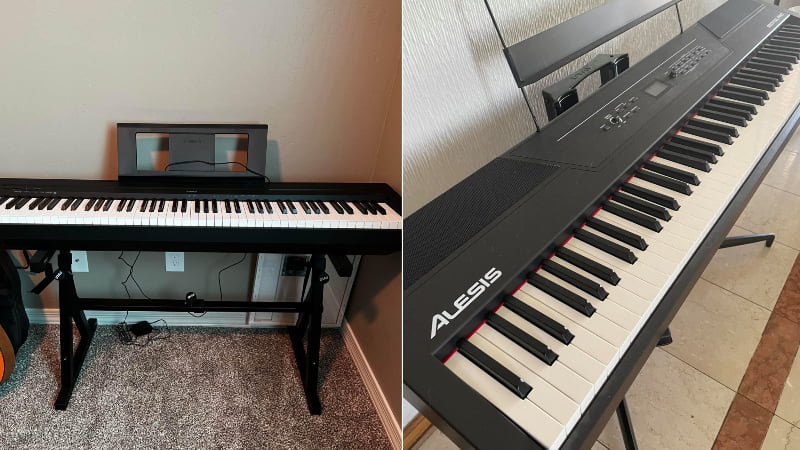While the Alesis Recital was the more affordable option, when compared to the more expensive P71, it simply doesn’t compare. So, after testing out both of these options, I found that the Yamaha P71 was the easy winner because of its superior tone, feel, and voices that give beginner and novice pianists a lot of room for experimentation.
However, in the Yamaha P71 vs Alesis Recital comparison, the Alesis model has a couple of features that stand out. It has MIDI connectivity, great speakers, and decent polyphony. So, if you’re on a tight budget, the Alesis Recital can make for a great option.
While it’s more expensive, the P71 can serve you very well during your first few years as a pianist while you progress through the different levels. The Alesis Recital, on the other hand, is great while you’re a beginner, but after some time, you might find yourself needing to upgrade to a better model.
Yamaha P71 vs Alesis Recital: Comparison Chart




Last update on 2025-03-08 / Affiliate links / Images from Amazon Product Advertising API
Yamaha P71 vs Alesis Recital: Differences
The best way to judge these two pianos was to compare their features and differences. And after testing out the models side by side, the Yamaha P71 was the clear winner by 3-2. This is because while the Alesis had a better built-in sound system, the Yamaha P71 has better accessories, feel, and tone compared to the Alesis Recital.
Hammer Action
The winner: Yamaha P71
The Yamaha P71 has fully-weighted keys, so right off the bat, it’s much better than the Alesis Recital’s semi-weighted keys. The only complaint I had with the Yamaha P71’s hammer action was that it wasn’t progressive, so the weight is almost the same throughout the whole piano. An acoustic piano’s keys are heavier on the left side and lighter on the right side, which would have been a great feature to add, considering many of Yamaha’s pianos are equipped with Graded Hammer Action Systems (GHS).
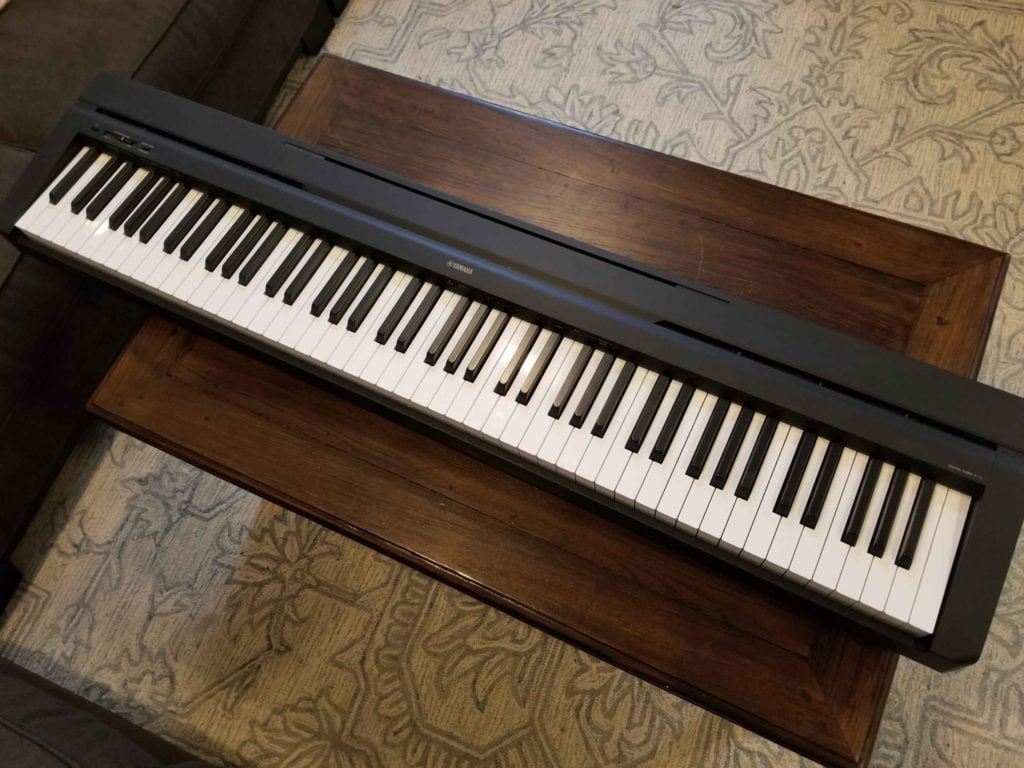
With all that said, fully-weighted keys always beat out semi-weighted keys. While the keys on the Alesis Recital may be easier to play for beginners since they’re lighter, it doesn’t simulate the feel of a real acoustic piano. This helps keep the cost down, which is why the Alesis is the more affordable option, but in the long run, it’s not the best feature for a digital piano to have. Most pianists don’t enjoy the feel of semi-weighted keys, which is a common complaint that most customers had with this model.
Tone
The winner: Yamaha P71
When it comes to tone, the Yamaha P71 knocks it out of the park. It has better tone generation, a wide voice library, and the only area where it’s slightly lacking is the effects. But overall, if you’re looking for an accurate piano sound and other fun voices, the Yamaha P71 easily beats out the Alesis Recital.
Tone Generation
Both of these pianos generate their tone through samples. However, the Yamaha P71 does it with the Yamaha Advanced Wave Memory (AWM) technology, which provides for higher quality sounds and voices compared to the Alesis Recital. When developing the samples for this piano, Yamaha used advanced technology on their own grand and concert pianos with natural decay. Normally, pianos like the Alesis Recital use synthetic decay on their samples to save up on memory.
WIth the Yamaha P71, you get the all natural sample with natural decay. That way, your note dies out more naturally and it sounds more like a real piano. Yamaha also has the advantage of sampling their own pianos which are renowned worldwide for their tone and quality.
Voice Library
The Yamaha P71 has a voice library with 12 different voices. Aside from a variety of grand and concert piano tones, you also get bass tones, electric piano tones, and even strings. That way, you get to experiment with a wide range of different sounds, which is one of the joys of playing the piano.
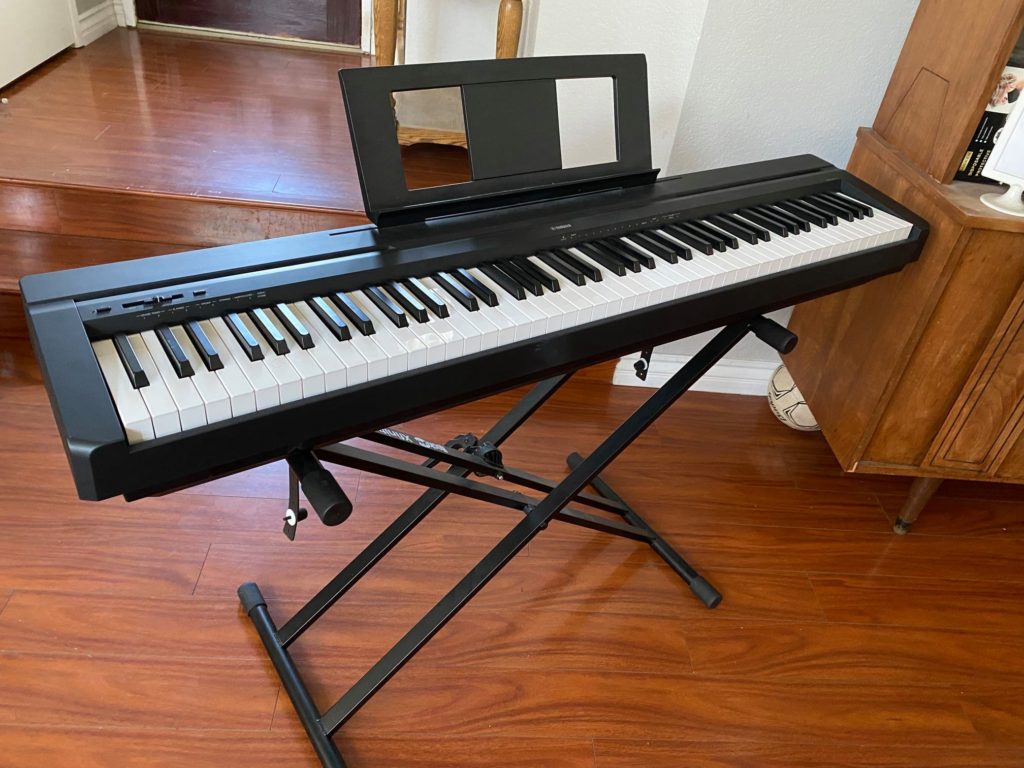
On the other hand, you only get 5 voices with the Alesis Recital. This is a very limited selection, but it does offer enough sounds for beginner pianists. The Alesis Recital offers piano, electric piano, organ, synth, and bass sounds. When you start out with the instrument, this will be more than enough. However, as you progress and your skill level improves, you might find yourself wanting a wider range of voices.
Effects
When it comes to effects, the Alesis Recital has a slight edge, but let me put extra emphasis on “slight”. The Yamaha P71 comes with built-in reverb with four different presets that you can tweak to your liking. On the Alesis Recital, you get a Reverb and Chorus effect, but you don’t have as much control over the sound.
So, at the end, you get around the same versatility in terms of effects. Since these are both fairly entry-level pianos, they don’t offer robust effects. The Alesis Recital has slightly more effects than the P71, but the P71 allows you to tweak and customize the sounds with much more precision and control than the Alesis Recital.
Piano Features
The winner: Alesis Recital
When it comes to the extra piano features available on the instrument, the Alesis Recital is the clear winner because of the different playing modes, better polyphony, and superior connectivity.
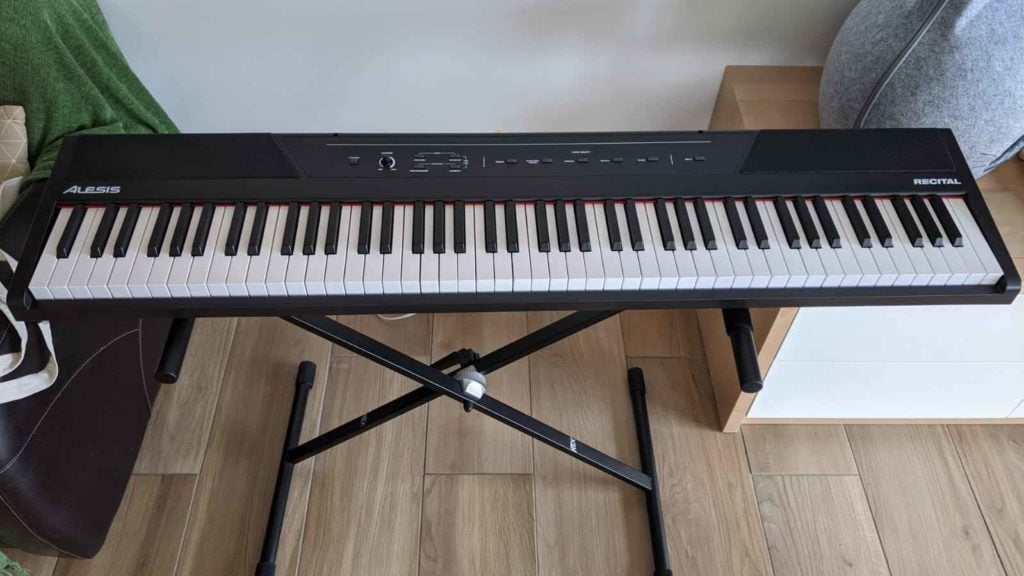
Modes
The Alesis Recital comes with lesson mode, split mode, and dual mode. With lesson mode, the piano can be divided into two smaller pianos with the same sound. That way, the teacher and the student can go about their lessons without worrying about crossing over to the other side. With split mode, you can assign different voices to the right and left side of the piano, allowing you to seemingly play two instruments at a time. And with dual mode, you can combine two separate voices for a full and unique sound.
With the P71, you only get dual mode as an extra playing mode. This isn’t the end of the world, but it is definitely lacking when compared to the Alesis Recital.
Polyphony
When testing out these two pianos, I was pleased and surprised to learn that the Alesis Recital has 128-note maximum polyphony. This allows pianists to play multiple notes at the same time and still expect a crisp and clear sound. Granted, the tone of the Alesis Recital isn’t as great as the P71, but at least you get more clarity when playing wide and complex chords.
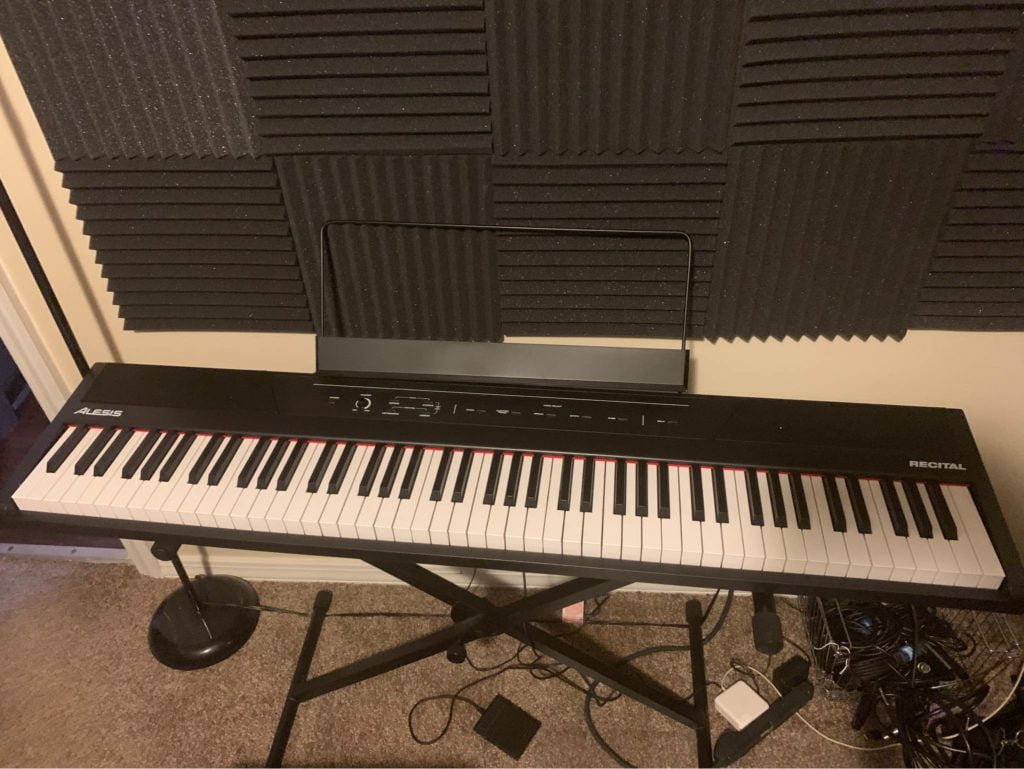
The Yamaha P71 only has 64-note maximum polyphony. This still allows for clear chords, but it is admittedly not as crisp as what you’ll hear on the Alesis Recital.
Connectivity
The reason the Alesis Recital beats out the P71 in this regard is that it comes with MIDI connectivity. That way, you can connect the Recital to your computer and use it for virtual instrument plugins or even use it for piano lesson apps. So, you can sort of use this piano as a MIDI controller, which is a huge plus for people looking to make their own music.
Sadly, the Yamaha P71 doesn’t come with any MIDI connectivity options, which means that you can only use it as a digital piano.
Sound System
The winner: Alesis Recital
Another area where the Alesis Recital beat out the P71 is in terms of the sound system. The Alesis Recital has two 20W speakers. So, it will be more than loud enough for rehearsing on your own. On top of that, if you’re jamming with other musicians, chances are you won’t have to plug into an external sound system.
If you need to plug into an external sound system, the Alesis Recital has an RCA stereo output. So, you can connect to external speakers easily, but if you want to connect to an amp, you will need a ¼’’ adapter. Another advantage of the Alesis recital is a headphone output you can use for silent and quiet practice sessions.
On the Yamaha P71, you only get two 6W speakers. This is only fit for practicing alone or performing for a few friends or family members. However, it does have a ¼’’ output you can use to connect to an external sound system or amp. It also has a headphone output, but is still lacking when it comes to speaker size and quality.
General Features
The winner: Yamaha P71
This is another area where the Yamaha P71 beats out the Alesis Recital since it comes with more accessories and the Yamaha brand has a better reputation for pianos.
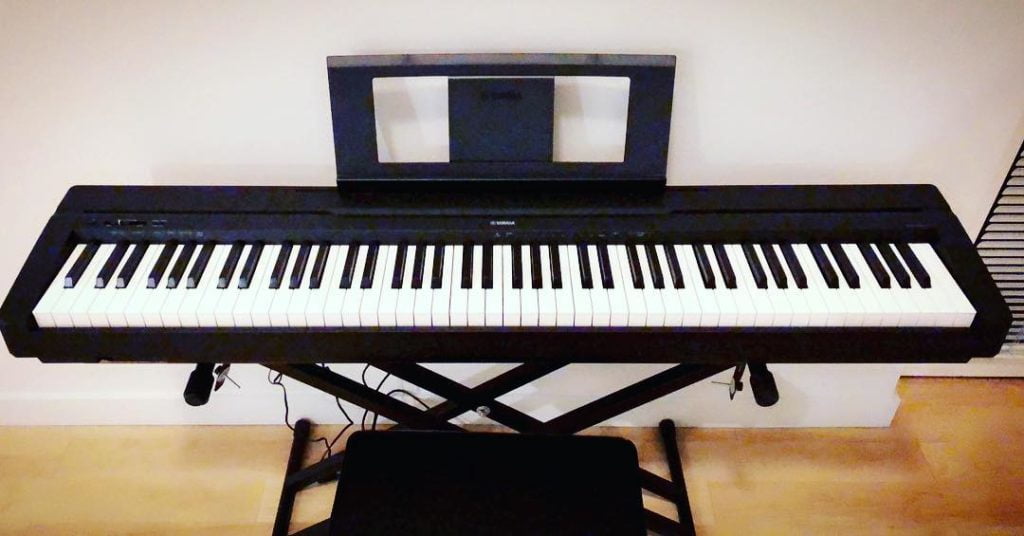
Brand
Both Yamaha and Alesis are known for making great digital pianos. However, Alesis is mostly reserved for their digital instruments, while Yamaha is known for a wide variety of instruments. One of the reasons the Yamaha P71’s tone is better than Alesis is that the brand actually sampled Yamaha pianos that are known worldwide.
Yamaha is one of the most versatile brands out there and is known for top quality in all the products they produce. Alesis, on the other hand, is a much smaller brand known mostly for mid-range and beginner digital instruments.
Accessories
The Alesis Recital doesn’t come with a sustain pedal, but it does come with a power adapter. On the flip side, the Yamaha P71 comes with a power adapter, music rest, and sustain pedal, giving you just about everything you need when it comes to playing the piano. The only extra accessory the Alesis Recital has over the P71 is a 3-month premium subscription to Skoove, which is a great tool for beginners trying to learn to play the piano.
Yamaha P71 vs Alesis Recital: The Similarities
The Yamaha P71 and Alesis Recital are both full-key keyboards designed for beginners. They are portable, compact, and lightweight, which is why they’re ideal for students. But at that point, the similarities come to an end. These are two very different instruments, which is why it was a joy to review and compare them to see how they stack up against each other.
And while both options are great pianos for beginners, if you’re looking for something to last you a longer time, my recommendation is the Yamaha P71, hands down.
Quick Rundown of the Yamaha P71
- Acoustic Piano Feel - Touch-sensitive keys allow for true expression and dynamic performance. The weighted action replicates the acoustic piano experience
- Elevated Sound - Choose from 10 unique Voices, including the richness and resonance of a Yamaha grand piano, with full dynamic sound and deep bass
- Effortless Control - Simple one-button operation and streamlined functionality designed to keep you focused on your music
- Layered Sound - Dual Mode lets you blend two Voices, like piano and strings, creating a rich, layered sound for an inspiring new playing experience
- Included sustain pedal allows for subtle variations and greater expression in your performances
Last update on 2025-03-08 / Affiliate links / Images from Amazon Product Advertising API
Quick Rundown of the Alesis Recital
- An Electric Piano That’s Tailored to You - Feature-packed Electric keyboard with 88 premium full-sized semi weighted keys with adjustable touch response to suit your preferred playing style
- Premium Sounds - 5 voices (Acoustic Piano, Electric Piano, Organ, Synth, and Bass), built-in FX: Chorus, Reverb, and two built in 20W speakers that deliver crystal-clear, room-filling sound
- All The Right Connections - ¼” sustain pedal input (pedal not included), ¼” stereo headphone output for private practice and stereo RCA outputs for connection to speakers / amplifiers
- Play the Keyboard Wherever You Go - Power via the included power adapter or 6 D cell batteries (not included) for professional piano performance anywhere
- Powerful Educational Features - Standard, split, layer, and lesson modes with 128-note max polyphony and Skoove 3 month premium subscription for expert interactive online piano lessons
Last update on 2025-03-08 / Affiliate links / Images from Amazon Product Advertising API
Product Video:
Related Articles to Yamaha P71
- Alesis Virtue Vs Yamaha P71: Can The Alesis Console Piano Beat Out The Amazon Exclusive?
- Yamaha P71 vs P95: Which Is The Better Digital Piano?
- Yamaha P71 vs Korg B2 Comparison: Battle Of the Two Top Beginner Pianos On the Market
- Yamaha P71 vs Casio CDP-S150: Which Is the Best Beginner Piano On the Market?
- Yamaha P71 vs DGX-660: Can the Amazon Exclusive Beat Out the Premium Model?
- Yamaha P71 vs Donner DEP-20: Which Is the Best Beginner Piano?
- Yamaha P71 vs Casio PX-160 Comparison: Battle of the Two Best Digital Pianos on a Budget
- Yamaha P71 vs Roland FP10 Review: A Tight-Knit Battle Where The FP10 Comes Out On Top
- Yamaha P71 vs Alesis Recital Pro: Which Digital Piano is the Best Option for Beginners?
- Yamaha P71 vs P125: Why the Yamaha P125 Is the Better Investment
- Yamaha P71 vs P45: Why the Amazon Exclusive P71 is the Better Digital Piano
Related Articles to Alesis Recital
- Alesis Recital vs Williams Legato: The Best Beginner Pianos on the Market?
- Alesis Recital vs Thomann SP-320: Which ls the Better Piano?
- SDP-2 by Gear4Music vs Alesis Recital: The Best Entry-Level Digital Pianos?
- Alesis Recital vs Roland GO Piano (P-61): Should You Invest In The Recital Pro?
- Alesis Recital Vs Yamaha P125: Which Is The Right Pick For You?
- Alesis Recital Vs RockJam 88: Which $200-Digital Piano Gives More Value?
- Alesis Recital Vs Yamaha NP12: Which Of The Two Suits Your Needs?
- Alesis Recital Vs Yamaha NP32: Which Is Better For Beginners?
- Alesis Recital Vs Yamaha P45: Which Offers Great Value For Money?
- Donner DEP-10 Vs Alesis Recital: Which Is The Best Semi-Weighted Digital Piano?
- Alesis Recital vs Concert: Which Is The Better Piano For Beginners?
- Alesis Recital vs Alesis Recital Pro: Should You Invest In The Recital Pro?
References:
- RECITAL 88-Key Digital Piano with Full-Sized Keys: https://www.alesis.com/products/view/recital
Lulacruza is an electronic folk duo operating at the junction of the hypermodern and the ancient. Our music weaves together hypnotic female singing, South American folk instruments and electronic processing, while channeling pulsating waves from the source of creation.
Lalucruza is also a community where you can connect with other music lovers to collaborate, exchange ideas and share knowledge. A platform for who wants to learns the basics of playing piano, guitar, drum masters’ technique, etc.. is the premise of our website.
